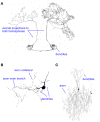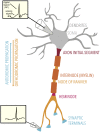Axonal Computations
- PMID: 31619963
- PMCID: PMC6759653
- DOI: 10.3389/fncel.2019.00413
Axonal Computations
Abstract
Axons functionally link the somato-dendritic compartment to synaptic terminals. Structurally and functionally diverse, they accomplish a central role in determining the delays and reliability with which neuronal ensembles communicate. By combining their active and passive biophysical properties, they ensure a plethora of physiological computations. In this review, we revisit the biophysics of generation and propagation of electrical signals in the axon and their dynamics. We further place the computational abilities of axons in the context of intracellular and intercellular coupling. We discuss how, by means of sophisticated biophysical mechanisms, axons expand the repertoire of axonal computation, and thereby, of neural computation.
Keywords: action potential generation; analog-digital signaling; axo-axonal coupling; capacitance; myelin; propagation; resistance.
Copyright © 2019 Alcami and El Hady.
Figures






References
Publication types
LinkOut - more resources
Full Text Sources

